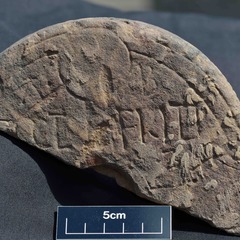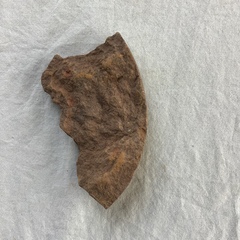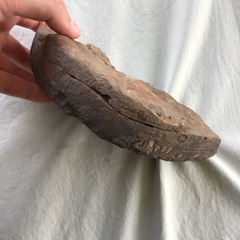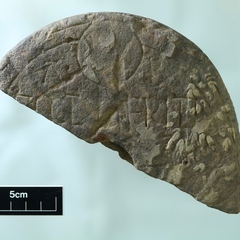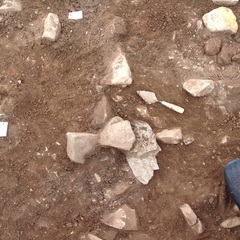- Anglo Saxon inscribed name stone in two fragments that are funerary related
Interpretation
-
- BY DR ELIZABETH OKASHA (University College Cork) Lindisfarne XV Examined 1 August 2016 Found during excavation on Lindisfarne June 2016 and currently in the care of the Department of Archaeology, University of Durham. The stone was found in a spread of rubble to the east of the priory along with fragmented human bone. A carved but uninscribed stone was found nearby and also an Anglo-Saxon coin, a sceatta. The most-recently found Lindisfarne stone, apart from the current one, was also found to the east of the priory, in 1957 in a field known as Sanctuary Close .
-
- David Petts
- 3-5-2017
3-D Models
Comments
- The inscribed stone consists of the top portion of a round-headed sandstone cross-slab. The back of the stone is plain as are the remaining original edges. On the face are parts of the top and right-hand arms of an incised cross. The terminals of the cross are circular and continue to the edge of the stone, protruding on to the incised double margin. A portion of the descending top cross-arm is visible as is a small part of the medial circle of the cross, which appears to be slightly sunken. When complete, the maximum width of the stone would have been c. 16 cm but its height is not now recoverable. The stone clearly fits well with the existing fourteen Lindisfarne cross-slabs in that: it is decorated only on the face, as most are; it is inscribed, as most are; and it has an incised cross probably with a sunken medial circle . However the incised cross seems more crudely executed than those on some of the other stones and the cross terminals and the border are plain, not decorated, as on some of the others. It is possible that the decoration was less skilfully executed or that the stone was left unfinished. When complete the current stone would probably have been one of the smaller of the series, with a width of c. 16 cm: the widths of the others vary between 13.7 and 32 cm. Text 1 is set in the two upper quadrants of the incised cross, the two elements of the name separated by the descending cross-arm. This position is typical of the texts of others of the Lindisfarne stones. Text 2 is set on either side of the upper cross-terminal. In both cases, the texts are incised and are set horizontally without framing-lines or panels: this is entirely typical of the series of Lindisfarne stones. Both texts are legible and primary, that is, the stone was always intended to contain a text. There are some other marks which might resemble letters but are more probably accidental or later damage: one appears beneath the I of FRID in Text 1, and the other before the first letter of Text 2. Readings of the texts Text 1 reads: YT FRID where the underlined letter indicates that it is slightly damaged. The form of the initial letter Y is very similar to that used on Lindisfarne II and also on a stone from Lancaster, Lancaster II . It is possible, but in my view less likely, that the reading of the first part is EAT. This text can plausibly be interpreted as a new personal name *YÞFRIĐ. The second element -frið is a common element in Anglo-Saxon male names and there is at least one recorded instance of its forming a female name, Ecgfrið . The first element yþ- is rare but there is one occurrence, in a female name Ythsuið in the Durham Liber Vitae . An alternative explanation, with the reading EAT, is that this is a possible reading of an unusual spelling of the recorded name Eadfrið. This name occurs occasionally with the spelling eatfrið, for example in the Durham Liber Vitae . Spellings of T and D for Þ and Đ (both of which represent the sound spelled today as th) can readily be paralleled in both manuscript and epigraphic usage. The following are some epigraphic parallels: T appears in the name Helmgyth on Jarrow VI ; D is used on Jarrow I, the Jarrow dedication stone, in the names Ceolfrith and Ecgfrith , as well as in Torhtswith on Hartlepool IV . Text 2 reads: A W although the letter read as W is set on its side and has the loops closed, thus making it superficially resemble the letter B. The text forms the abbreviations for alpha and omega, the reference being to the biblical text Revelations XXII, 13. Alpha and omega occur in a number of Anglo-Saxon inscribed texts. The closest parallel is on the Hartlepool cross-slab, Hartlepool VI . On this stone the text appears in the two upper quadrants of the cross with a personal name set in the two lower quadrants. In this case also the omega is of an unusual form; it resembles a circle with a vertical line set through its centre. Conclusion The newly-found stone, named here as Lindisfarne XV, is regrettably fragmentary. Nevertheless it forms a nice addition to the existing series of fourteen Lindisfarne cross-slabs. It is also likely that it furnishes us with a previously unrecorded Old English personal name. References • Cramp 1984: R. J. Cramp, Corpus of Anglo-Saxon Stone Sculpture in England. 1 County Durham and Northumberland (Oxford, 1984) • Okasha 1971: E. Okasha, Hand-list of Anglo-Saxon Non-runic Inscriptions (Cambridge, 1971) • Okasha 1983: E. Okasha, ‘A supplement to Hand-list of Anglo-Saxon Non-runic Inscriptions’, Anglo-Saxon England 11, 83-118 • Okasha 2011: E. Okasha, Women’s Names in Old English (Farnham, 2011) • Sweet 1885: H. Sweet, The Oldest English Texts (Oxford, 1885) 1 fragment, Length - Width - Thickness -
From Context
-
Context: LDF_2004
- John Horrocks 29-6-2016
